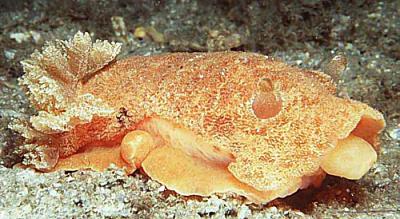
Discodoris spp - west Atlantic warm water
Order: NUDIBRANCHIA
Suborder: DORIDINA
Superfamily: EUDORIDOIDEA
Family: Dorididae
PHOTO
West Palm Beach, Florida, USA., 12 feet of water, 3 inches long. February, 2001. Photo: Anne DuPont
Unidentified species from the Caribbean and surrounding regions.
Marcus & Marcus (1967) describe a number of new species of Discodoris and dorids with a simiar external appearance, and review many others. Unfortunately the information on the external colour of the living animals is not good. Eveline Marcus (1977) lists 8 species of Discodoris from the Caribbean region, though I have no idea how many of those are valid species or even species of Discodoris.
Two reported most frequently are Discodoris evelinae Marcus, 1955 and Discodoris pusae Marcus, 1955. Both are reported to swim and autotomise the mantle. D. evelinae is reported to have penial spines while D. pusae does not. Much further work by resident workers will be needed before this group of species in the Caribbean can be confidently identified.
References:
• Marcus, Er (1955) Opisthobranchia from Brazil. Boletim da Faculdade de Filosofia, Ciencias e Letras. Universidade de Sao Paulo, Zoologia, 20: 89-261. (Pls. 1-30)
• Marcus, Er. & Marcus, Ev. (1967) American opisthobranch mollusks. Part 1, Tropical American opisthobranchs. Studies Tropical Oceanography, Miami, 6(1-2): 1-137. (Figs 1-150, Pl.1, figs 1-9)
• Marcus, Ev (1977) An annotated checklist of the western Atlantic warm water opisthobranchs. J. Moll. Stud. (Suppl. 4): 1-23.
• Thompson, T.E. (1980) Jamaican opisthobranch molluscs: II. J. Moll. Stud., 46(1): 74-99.
Rudman, W.B., 2001 (March 7) Discodoris spp - west Atlantic warm water [In] Sea Slug Forum. Australian Museum, Sydney. Available from http://www.seaslugforum.net/find/disccari
Related messages
Re: Discodoris ? from Florida
August 15, 2008
From: Geoffrey Smith
Concerning message #21687:
Hey Bill,
Thanks for the potential ID on this nudibranch. If I find any more I'll try to get some pictures with better resolution and color now that I have access to some better cameras.
Geoff
geoffreyhsmith@gmail.com
Smith, G.H., 2008 (Aug 15) Re: Discodoris ? from Florida. [Message in] Sea Slug Forum. Australian Museum, Sydney. Available from http://www.seaslugforum.net/find/21806Thanks Geoff,
If you do find any more, a photo of the underside is often as important as a photo of the dorsal side. It can be difficult to photograph upside down as they usually immediately try to turn the right way up, but we are not after a centre-page portrait - just an idea of the colour pattern.
Best wishes,
Bill Rudman
Discodoris ? from Florida
July 29, 2008
From: Geoffrey Smith
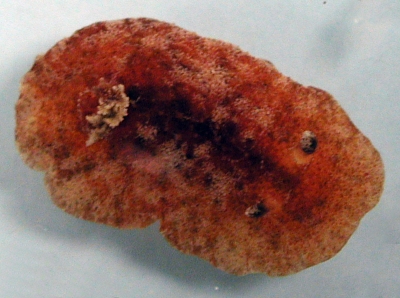
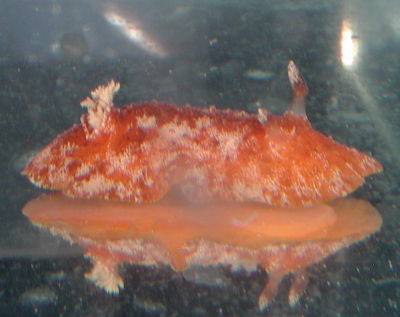
Dear Bill
This is the last of the nudibranch I found in Sarasota over the past few years that I was unable to ID. I believe it is some type of dorid nudibranch. It is orange is color and 1-2 inches in length. These were collected while pushing dip nets across a seagrass bed consisting mainly of Thallasia testudinum of and Syringodium filiforme. This nudibranch was often collected at the same time as the small green sea slug I previously sent you a message about. Any thoughts on an ID for this one?
Locality: New Pass in Sarasota, 2-5 feet, Florida, United States, Gulf of Mexico, several times in 2007 and 2008, seagrass bed. Length: 1-2 inches. Photographer: Geoffrey Smith.
On a side note I figured I would give you a list of other sea slugs I have found in Sarasota, FL: Aplysia morio, A. brasiliana, A. dactylomela, Bursatella leachii, Elysia spp., Oxynoe antillarum, Lobiger souverbii, Dondice occidentalis, Spurilla neapolitana, Haminoea solitaria, Bulla striata, Polycera hummi, Chromodoris clenchi, and Scyllaea pelagica. I think that is all of them.
Geoff
geoffreyhsmith@gmail.com
Smith, G.H., 2008 (Jul 29) Discodoris ? from Florida. [Message in] Sea Slug Forum. Australian Museum, Sydney. Available from http://www.seaslugforum.net/find/21687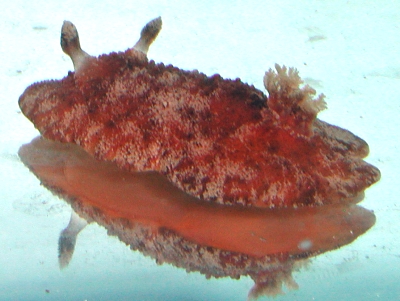
Dear Geoff,
The easiest answer would be Platydoris angustipes which looks like this in general shape and colour, but the raised rounded papillae all over the mantle don't look like a species of Platydoris at all. It looks to me like a species of Discodoris, but the common one you are likely to come across would be Discodoris evelinae, and although I am no expert on the fauna, I don't think a reddish colour form has been reported. Also the underside of D. evelinae is pale whitish with brown spots. From the reflection in your photos the underside is a uniform translucent pinkish colour.
Hopefully someone will recognise it for us. At present I will put it on the miscellaneous west Atlantic Discodoris page. Hopefully it won't stay there long
Best wishes,
Bill Rudman
Discodoris evelinae? from Florida
September 26, 2002
From: Linda Ianniello
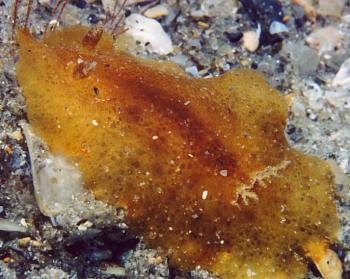
Dear Bill,
Attached is a photo of what could either be Discodoris evelinae (from the photo and description in Paul Humann's book) or Discodoris spp - Atlantic Warm Water - on the forum. It was found in the same area that Anne DuPont found the Discodoris spp - at West Palm Beach, Florida, at a depth of about 12 feet. However the skin texture appears different. What do you think?
Regards,
Linda I.
lindai@us.ibm.com
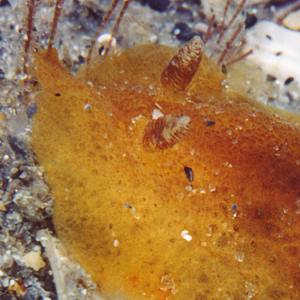
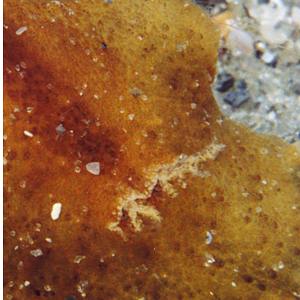
Dear Linda,
What do I think? I think it is best to leave this group alone until a resident worker decides to study them in some detail so we can get an idea of colour variation and comparative anatomy. Many species have been described, but whether they are good species or not cannot be determined by our present knowledge. So at the moment I can only leave it on the 'Discodoris spp - Atlantic Warm Water' page. using 'spp' as I have here is shorthand for species [plural]. Its a place to 'dump' all Discodoris - looking animals. It could be there are more than one species here, certainly your animal and Anne's could easily be different species.
Best wishes,
Bill Rudman
Dorid from Florida, USA
March 13, 2001
From: Anne DuPont
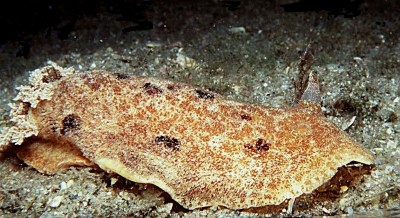

Bill,
Last month [Feb 10, 2001] I was diving off West Palm Beach in about 12 feet of water when I found this critter. It was about 3 inches long.
Can you identify it for me?
Thank you for all your help.
Cordially,
Anne DuPont
adupont@gate.net
DuPont, A., 2001 (Mar 13) Dorid from Florida, USA. [Message in] Sea Slug Forum. Australian Museum, Sydney. Available from http://www.seaslugforum.net/find/3815Dear Anne,
From your photos this animal is a species of Discodoris. Apart from the general shape and the papillate mantle, one feature quite typical of the genus is the piece broken off the side of the mantle. This ability to break off pieces of the mantle is called autotomy and is a defensive strategy much like a lizard dropping its tail.
I can't be sure which species this is. Eveline Marcus (1977) list 8 species of Discodoris from the Caribbean region, though I have no idea how many of those are valid species or even species of Discodoris.
Discodoris evelinae Marcus, 1955 is reported from Florida to swim and autotomise parts of its mantle (Marcus, 1967) and Discodoris pusae Marcus, 1955 is reported from Jamaica to also swim and autotomise the mantle (Thompson, 1980). D. evelinae is reported to have penial spines while D. pusae does not.
So basically I can't b sure which species you have. Hopefully there is someone with local knowledge who can help.
References:
• Marcus, Er (1955) Opisthobranchia from Brazil. Boletim da Faculdade de Filosofia, Ciencias e Letras. Universidade de Sao Paulo, Zoologia, 20: 89-261. (Pls. 1-30)
• Marcus, Ev (1977) An annotated checklist of the western Atlantic warm water opisthobranchs. J. Moll. Stud. (Suppl. 4): 1-23.
• Thompson, T.E. (1980) Jamaican opisthobranch molluscs: II. J. Moll. Stud., 46(1): 74-99.
